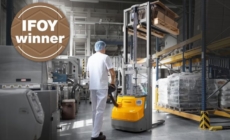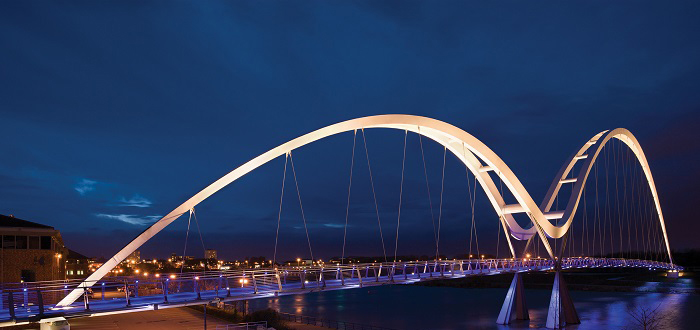-
ROSSLARE EUROPORT TARGETS HEALTH & SAFETY WITH CAMERA TELEMATICS PARTNERSHIP - 2 days ago
-
Landmark Study Reveals Wearable Robotics Significantly Boost Safety and Efficiency in Industrial Environments - July 24, 2024
-
Visku Tackle The Retail Seasonality Challenge One Pallet At A Time - July 22, 2024
-
KAMMAC AND BERGEN LOGISTICS STRENGTHEN FASHION & LIFESTYLE SERVICES IN THE UK - July 19, 2024
-
TENTBOX EXTENDS PARTNERSHIP WITH ARROWXL TO SUPPORT INCREASING DEMAND - July 17, 2024
-
The Perfume Shop improves customer journeys while driving profitability in partnership with Scurri - July 17, 2024
-
ZEROMISSION SECURES £2.3M ($3M) INVESTMENT TO ACCELERATE ELECTRIC FLEETS - July 16, 2024
-
BCMPA CELEBRATES SUCCESS OF 2024 CONFERENCE - July 15, 2024
-
Best of the Best: Jungheinrich Celebrates Triple International Award Win - July 12, 2024
-
GOPLASTICPALLETS.COM CALLS ON NEW CHANCELLOR RACHEL REEVES TO CONSIDER PLASTIC PACKAGING TAX REFORM - July 10, 2024
Lighting the logistics sector – switching on to the ‘as a service’ approach
Graeme Shaw, Technical Application and Academy Manager, Zumtobel Group
The UK logistics sector is all about scale. According to Ecommerce News, business-to-consumer ecommerce turnover in the UK increased 13.65 percent to £13.7 billion last year. For next year, a growth rate of 14.3 percent is predicted, which means ecommerce in the UK could be worth £15.9 billion. This growth has led to huge investment in the physical infrastructure required to process this parcel volume. The BBC reports that warehouse space has nearly doubled over the last 10 years, now equating to some 235 million sq feet – the equivalent of 3,000 Wembley Stadiums.
Behind all these numbers lie some clear challenges, not least around energy efficiency and driving down operating costs. Historically, lighting has not been a major consideration for the sector. But a new mindset is emerging. The sector’s leaders are embracing the new idea of light as a service, whereby the future performance of the lighting solution is ensured by the supplier, and where no capital outlay is required.
The light as a service model enables logistics companies to look far beyond what would otherwise be possible without such a financing model in place. Put simply, businesses can upgrade the way in which light is used within their environment and pay for it using savings generated from day one of installation.
Tailored for purpose
Certainly, the cost-savings and energy efficiencies delivered by today’s LED lighting systems are compelling. The sheer size of warehouse environments means a lot of lights – which in turn means the potential for huge inefficiency if lighting is not optimised. Switching from older, legacy lighting systems such as sodium, metal halide or fluorescent to LED can lead to energy savings of over 80%.
Efficiency is not solely down to the type of lighting that is used, it is also about how that light is controlled. In many cases, the default lighting operation remains simply ‘on’ or ‘off’. Today’s advanced lighting controls serve light at a level and frequency that perfectly matches occupancy levels and specific tasks. So, light controls can detect the presence of people and switch on or off accordingly. And light levels can be increased or decreased depending on the activity taking part in a particular space. Bulk storage areas may require less illumination than sorting and packing stations, for example.
The light as a service model delivers immediate and ongoing access to lighting industry experts, individuals who are trained to assess the operating environment and who have the experience and depth of knowledge to suggest best-fit lighting solutions. Light can be tailored and controlled to suit a client’s specific needs.
Doing nothing is expensive
The future-proofing advantages of light as a service are critical. Without such a model in place, every new technological advancement would require significant capital expenditure. Light as a service provides buyers with the necessary consultative expertise to enable them to stay a step ahead. Additionally, any decision-maker will surely welcome the prospect of dealing with just one supplier contact (safe in the knowledge that the system is being monitored and maintained in the background) rather than having to deal with multiple maintenance, management and sales personnel.
Such a service enables the sector to benefit from LED technology – and from future developments – without the hassle of owning and operating the lighting solution themselves.
Not only is electricity getting more expensive every year, maintenance costs are also increasing. Every day an obsolete lighting system is operating it causes unnecessary extra costs – through excessive electricity consumption, high failure rates and high maintenance charges. Doing nothing is expensive.
Time to switch
Changing any purchasing and business model will always require careful assessment, and moving to light as a service will be a step change for many. However, taking the decision now can lead to immediate savings and can result in a model that normally pays for itself from day one.
Everything associated with lighting – from design via installation and commissioning through to regular maintenance – will be handled by the expert provider, enabling logistics leaders to focus on core tasks. Once installed, transparent remote monitoring helps to achieve the agreed aims regarding illuminance and energy efficiency and – with expert guidance – to quickly identify opportunities to adapt and enhance usage patterns. Adjusting lighting to individual specific needs and implementing new functions isn’t a one-off task performed when installing the lighting, but rather continues throughout operations. In this way, possibilities for optimisation – in the areas of quality, efficiency and functionality – are constantly monitored.
Light as a service arrangements allow future cost savings to be harnessed to pay for today’s digital technology upgrade. Such arrangements are gaining attention precisely because they enable investment without capital commitment, moving the business model from buying technology, to paying for access to that technology.
Logistics providers require warehouse premises that are fit for purpose, and lighting is recognised as a critical contributor – not only to cost and energy efficiency but also to operational excellence. The combination of smart financing and smart technology is accelerating investment in the smart logistics environment.

































